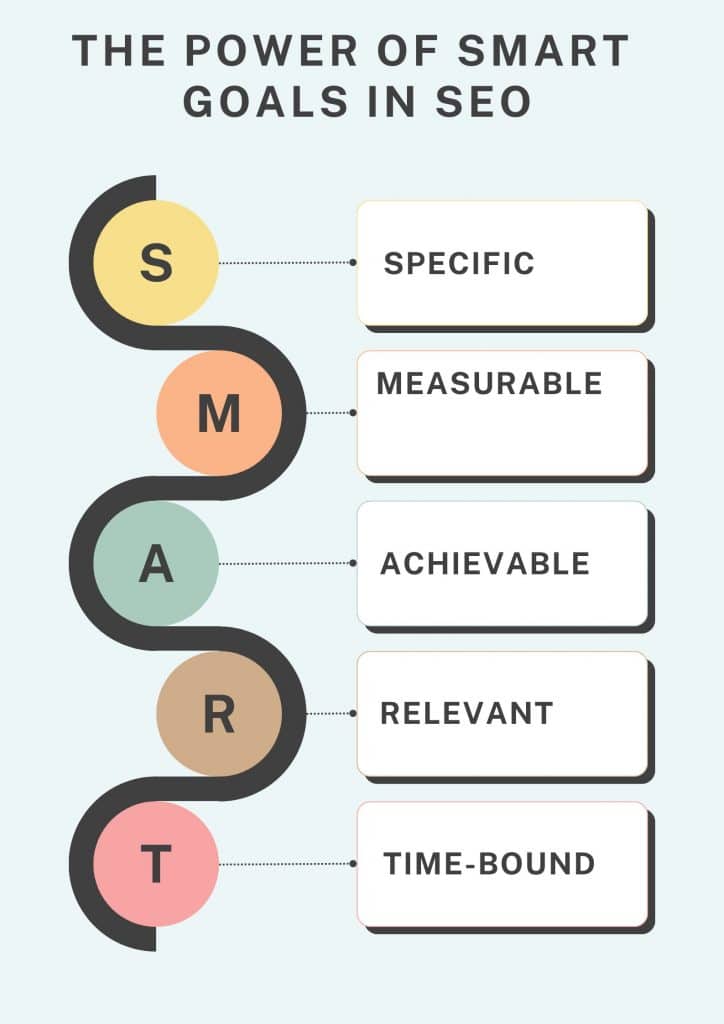When I started focusing on getting more people to visit my blog, I put a lot of effort into improving my website. But no matter what I did, I didn’t see much change in the number of visitors. Then, someone asked me a simple question that changed everything: “What are your SEO goals?” for getting more people to find your website through search engines?” I paused. SEO goals? This made me realize that I needed a clear plan, not just random things to try. But what should these goals look like? How do you set SEO goals that make a difference? If you’re curious about how to set these goals and why they matter, keep reading to uncover examples of SEO goals for 2024 to improve your website’s SEO visibility.
KeyPoint
- Setting specific SEO goals is essential to improving your website’s visibility and attracting organic traffic. These goals should align with broader business objectives, such as increasing revenue and customer engagement.
- The SMART (Specific, Measurable, Achievable, Relevant, Time-bound) framework is crucial for creating practical SEO goals. Each element ensures that goals are clear, trackable, and aligned with overall business strategies.
- Examples of practical SEO goals include increasing organic traffic from targeted keywords, generating high-quality backlinks, improving domain authority, enhancing user experience, and boosting mobile-friendliness. Each goal should have specific strategies and measurable targets.
- Key performance indicators (KPIs) like organic visibility, keyword rankings, click-through rate (C.T.R.), and conversions help track the effectiveness of SEO efforts. Monitoring these metrics allows stakeholders to gauge progress and adjust strategies as needed.
- E.O. goals should be integrated into the overall digital marketing strategy to ensure they contribute to business goals like brand awareness, web traffic, and sales. Aligning SEO efforts with business priorities helps demonstrate the value of SEO in achieving broader business outcomes.
What Exactly are SEO Goals?

Credit:rawpixel
They’re your specific targets to improve your website’s visibility and attract more organic traffic. These goals are closely linked to a company’s more significant aims, like increasing revenue and boosting customer engagement.
Think of SEO goals as milestones you want to reach through your SEO strategy. They help you measure progress and ensure your SEO efforts drive accurate results for your business. For example, if your goal is to increase organic traffic, your strategy would include keyword research, content optimization, and building high-quality backlinks.
Understanding Effective SEO Goals and Their Importance
SEO isn’t just about stuffing keywords into your content or getting as many backlinks as possible. It’s about strategically optimizing your website and content to rank higher in search results for relevant queries.
Managing an SEO project involves planning, communicating, and executing all your SEO tasks, with SEO goals playing a pivotal role.
Here’s why aligning your SEO goals with your business objectives is so crucial:
- Strategic Management: SEO goals become a part of your overall digital marketing strategy. They ensure your SEO efforts are coordinated and contribute to your business goals.
- Brand Awareness: Higher SEO rankings make your website more visible, helping potential customers find your brand when searching for solutions you offer.
- Web Traffic: Effective SEO brings more qualified visitors to your website, individuals genuinely interested in your products or services.
How SEO Goals Fit into Business Goals

Credit: DC Studio
These goals focus on SEO metrics directly impacting your more significant priorities, like getting more leads, increasing sales, or boosting organic traffic. This clarity ensures everyone is on the same page and that your SEO efforts are aligned with your more significant business objectives.
Practical SEO goals are always part of the bigger picture of your company’s overall goals. For instance, if you aim to expand into a new market, your SEO strategy might target specific keywords to boost visibility in that region. This alignment shows how SEO can add value and improve your business’s R.O.I.
Read: Strategies of Customer Acquisition: Best 2024 Practices
In essence, SEO goals connect the technical side of SEO with your broader business ambitions. By clearly defining what you want to achieve with SEO, you can use it to drive progress towards your overall goals.
SEO Goals for 2024
Here are the SEO goals your brand should target in 2024:
#1. Increase Organic Traffic from Targeted Keywords
To boost organic traffic, start by identifying high-volume, relevant keywords your target audience searches for. Aim to improve your rankings for these keywords over a specific timeframe. This strategy will drive more qualified visitors to your site, increasing conversions and boosting sales.
Quick Tips:
- Use Long-Tail Keywords: Target long-tail keywords with lower search volume but higher relevance. These keywords often have higher conversion rates because they address specific questions.
- Optimize for Featured Snippets: Tailor your content to provide clear, concise answers to questions, aiming for featured snippets in search results.
- Revamp Existing Content: Update older content with fresh data and better keyword placement.
Example Goal: Increase organic search traffic from the keyword ‘best-running shoes for beginners’ by 20% within the next quarter.
#2. Generate More High-Quality Backlinks
Backlinks are crucial for improving your website’s credibility and ranking. Aim to acquire a specific number of backlinks from high-quality websites within a set timeframe.
Quick Tips:
- Guest Blogging: Create high-quality content that people will link to, like studies, research, and infographics.
- Broken Link Building: Find relevant dead links on other sites and offer your content as a replacement.
Example Goal: Secure ten backlinks from websites with a domain authority (DA) of 50 or above within the next three months.
#3. Improve Domain Authority Score
Domain Authority (DA) predicts your website’s ranking potential. Your goal should be to increase your DA score by a specific percentage within a set timeframe.
Quick Tips:
- Post Consistently: Create high-quality, engaging content regularly.
- Spark Conversations: Encourage comments and discussions on your posts. Share your content on social media to drive traffic.
Example Goal: Increase DA score from 50 to 60 within the next six months.
#4. Enhance User Experience (UX) with Faster Page Load Times
A slow website frustrates users and hurts your performance. Improve your page load speed using techniques like image optimization and code minification.
Example Goal: Reduce website page load time by 2 seconds within the next month.
#5. Boost Mobile Friendliness
With most searches happening on mobile devices, having a mobile-friendly website is crucial. Focus on mobile responsiveness and user experience.
Quick Tips:
- Use Responsive Design: Ensure your layout adjusts to different screen sizes.
- Simplify Navigation: Use clear, extensive menus and consider a hamburger menu for less frequently used items.
- Optimize for Speed: Compress images and use efficient code.
Example Goal: Achieve a score of 90 or above on Google’s Mobile-Friendly Test within the next two months.
#6. Increase Content Engagement with Higher Dwell Time
Dwell time, or the time users spend on your site, is a crucial SEO metric. Aim to increase this by creating valuable, engaging content.
Quick Tips:
- Unique Content Angles: Offer fresh perspectives and surprising facts.
- Industry Insights: Partner with experts for exclusive insights and interviews.
- Content Hubs: Create clusters of related content to keep users exploring your site.
Example Goal: Increase average dwell time on blog articles by 30 seconds within the next quarter.
#7. Use Local SEO for Improved Visibility
Local SEO is essential for local businesses. Ensure your business information is accurate and up-to-date, and encourage customer reviews.
Quick Tips:
- Keyword Integration: Use local keywords throughout your content.
- Optimize Titles and Meta Descriptions: Include your location in title tags and meta descriptions.
- Local Landing Pages: Create specific pages for each location.
Example Goal: Achieve a top-3 ranking for the keyword ‘best plumber in [your city]’ within six months.
#8. Optimize Internal Linking Structure
A sound internal linking system helps search engines understand your site and improves user flow. Enhance your linking structure by strategically linking relevant pages together.
Quick Tips:
- Descriptive Anchor Text: Use keywords relevant to the linked page.
- Visual Formatting: Highlight important links with callout boxes or ‘Suggested Reading’ sections.
Example Goal: Implement a silo structure for blog content and link relevant articles within each silo by the next month.
#9. Increase Brand Mentions and Awareness through Online PR
Building brand awareness online supports SEO success. Aim to increase brand mentions through guest blogging, influencer outreach, or participating in industry forums.
Example Goal: Secure five guest blogging opportunities on high-authority websites within the next quarter.
#10. Improve Conversion Rates by Optimizing Landing Pages
SEO isn’t just about the traffic. It’s about converting that traffic into leads or sales. Optimize your landing pages by A/B testing elements like headlines, calls to action, and layout.
Example Goal: Increase the conversion rate of landing pages by 15% within the next quarter.
Read: What Is an SEO Manager: How to Become One, Skills, Jobs and Salary
Check out this comprehensive Content Optimization Checklist to ensure that your content is well-optimized for search engines and provides readers with a valuable, engaging experience.
How to Set SEO Goals
Setting and tracking realistic SEO goals is essential for measuring your SEO success. Here’s a simple way to approach it:
#1. Aim for SMART Goals
Ensure your SEO goals are SMART-specific, measurable, achievable, relevant, and time-bound. This framework ensures your goals are clear, focused, and trackable.
#2. Use SEO Tools and Website Analytics
Utilize powerful SEO tools and website analytics platforms to track your progress. Tools like Google Search Console, SEMrush, and Ahrefs provide valuable insights into your website’s organic traffic, keyword rankings, backlinks, and other key SEO metrics.
#3. Streamline Goal-Setting with ClickUp Goals
ClickUp Goals can simplify your goal-setting and tracking process. Integrate it with your preferred analytics tools to centralize your SEO data and make tracking easier. Here’s how to use ClickUp Goals:
- Create, manage, and track all your SEO goals in one place.
- Design custom dashboards to visualize your progress.
- Link SEO tasks to specific goals for a clear roadmap.
- Collaborate with your team by assigning tasks and sharing updates.
#4. Review and Improve Your SEO Goals
Schedule regular reviews (monthly or quarterly) to assess your progress and identify areas for improvement. Adapt your SEO approach based on new data, industry trends, and changing business objectives.
Define your SMART SEO goals and break them into smaller, actionable tasks. This helps prioritize your tasks and ensures your team is aligned on what needs to be done. Improve collaboration by keeping all your SEO data, goals, and functions in one place, allowing stakeholders to stay informed and provide input on any adjustments.
A visual SEO marketing roadmap makes it easy to see how your current goals align with your overall digital marketing objectives and business strategy. This prompts re-evaluation to ensure your ultimate goals remain relevant and achievable.
Read: What Is Digital PR Link Building? Why I Recommend It for Your SEO
The Power of SMART Goals in SEO
Using the SMART goals framework is nothing new. It’s widely adopted in project management, personal development, and psychology. I firmly believe in integrating time-tested marketing concepts into our SEO work. Combining your SEO skills with these proven methods can significantly boost performance.
I’ve found that applying SMART goals to SEO is a game-changer. Let’s break down the stages and see how you can create your own SMART SEO goals. See infographics:

S: Specific
Specificity is crucial for creating actionable SEO goals. A vague goal like “better rankings” isn’t helpful. Instead, aim for something precise like “ranking in the top 3 results for keyword X nationally.” A broader yet specific goal could be improving organic traffic by 25%. However, with broader goals, you need to think critically about how you will achieve them and clearly state that in your goal.
Ask yourself or your team:
- What are we trying to achieve?
- How does this help us achieve our marketing goals?
- What do we need to do to accomplish this?
Then, make your goal more specific: “Improve organic traffic by 25% by boosting the rankings for all commercial keywords on our category pages.”
Ensure your specific goals align with your business and marketing objectives. This connection provides a clear hierarchy of goals, making sure everyone understands what success looks like.
M: Measurable
To know if you’re making progress, your goals must be measurable. Thankfully, SEO offers plenty of metrics to track success.
Standard SEO metrics include:
- Rank for main converting keywords (local/organic)
- Rank for secondary benchmark keywords (local/organic)
- Organic clicks, impressions, and C.T.R. (Search Console)
- Organic average position (Search Console)
- Link-building metrics like total links built an authority site links
- Real-world metrics like increases in organic traffic, pages generating traffic, non-branded search traffic, and organic conversions
Identify metrics that help track progress, not just the end goal, so you can adjust tactics as needed.
A: Achievable
Your SEO goals should be realistic and attainable. While goals should be ambitious, they must also be achievable within your resources (money, workforce, etc.) and the competitive search landscape.
Evaluate your keywords and the current search results. Look at who is ranking and what opportunities exist. Consider what you can do better.
When assessing achievability, focus on:
- Quality: What can you improve?
- SEO feasibility: Are you competitive with the page 1 results?
- Situation: Are you in the same league as the top players?
- Resources: Do you have the resources to meet these goals?
If progress stalls, understand why and adjust your strategy accordingly. Remember, the best SEO goals evolve as you refine your approach.
R: Relevant
It’s easy to chase the wrong goals. Ensure your SEO goals are relevant by:
- Explaining how the goal helps achieve your overall marketing objectives
- Cross-referencing with conversion data from paid search
Relevance checks ensure your goals are a sensible use of resources and align with your overall mission.
T: Time-Bound
Every goal needs a deadline. You won’t know when to reassess progress or pivot your strategy without one. SEO can take longer to show results than other marketing tactics, so setting time-bound goals with milestones is crucial.
While it’s challenging to predict exact timelines for SEO, set your best estimates and review them as you progress.
Defining SMART SEO goals creates a clear path to success, ensuring your efforts are focused, measurable, and aligned with your broader business objectives.
What Is SEO Kpis?
SEO KPIs (key performance indicators) measure the effectiveness of SEO efforts. Common SEO KPIs include organic visibility, keyword rankings, organic click-through rate (C.T.R.), and conversions. By monitoring these KPIs, stakeholders can determine whether SEO strategies are effective.
Related Post
My SEO Workflow: A Comprehensive Guide to Boosting Your Search Rankings
An Introductory Guide to Black Hat SEO & Link Building in 2024
SEO Reporting Tools for Agencies: A Comprehensive Guide






